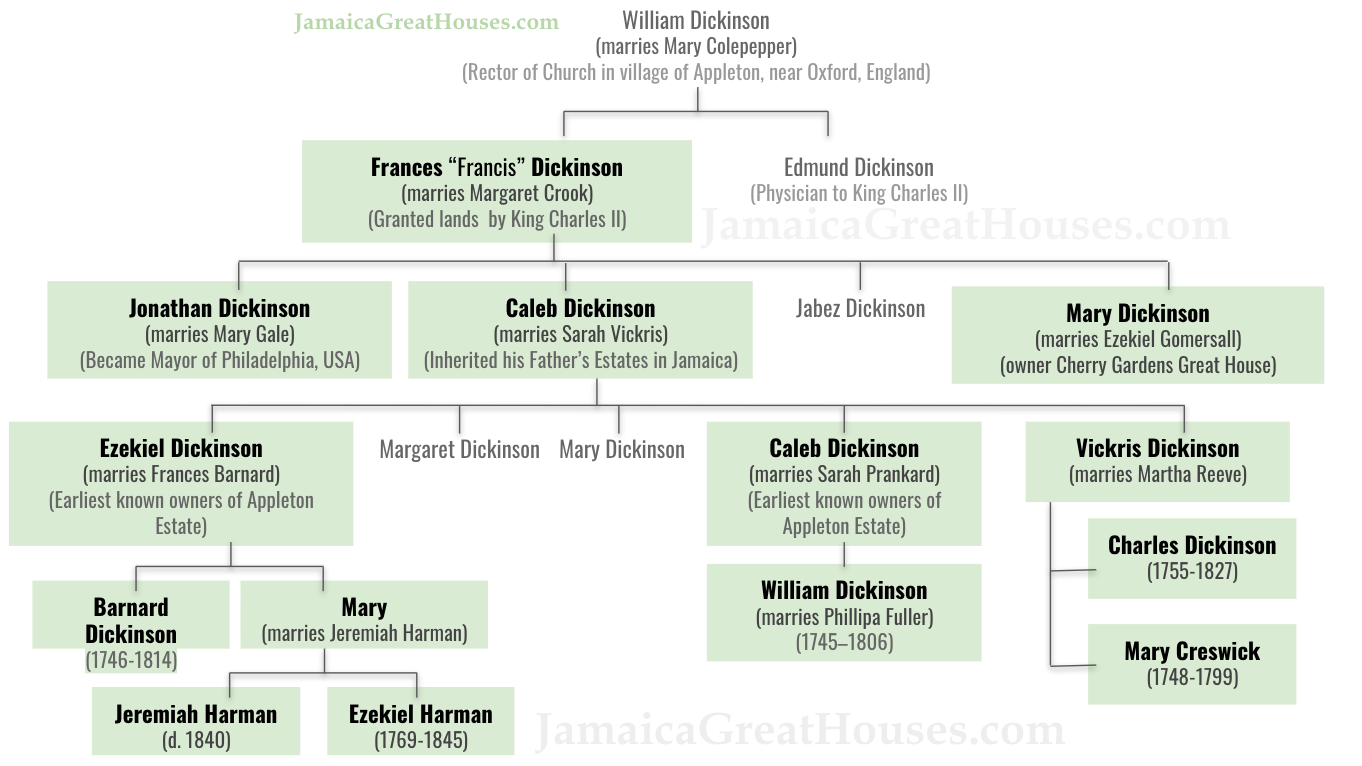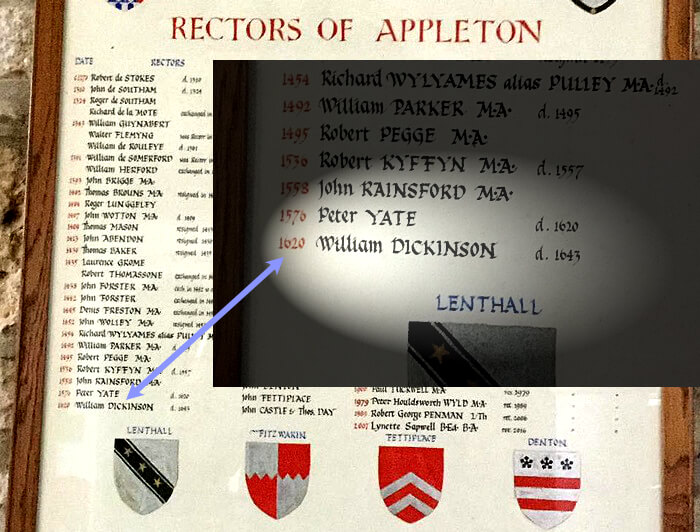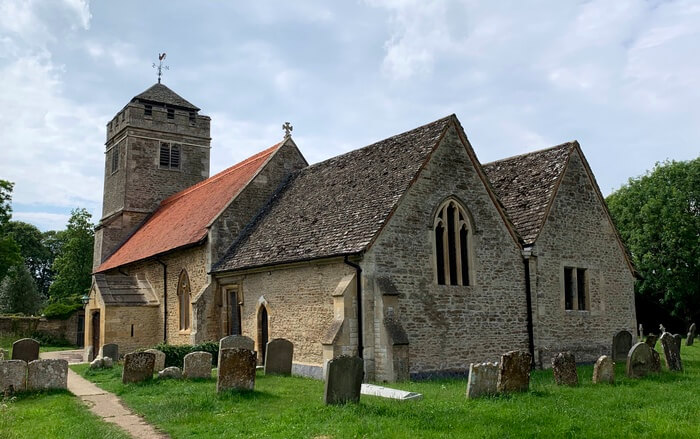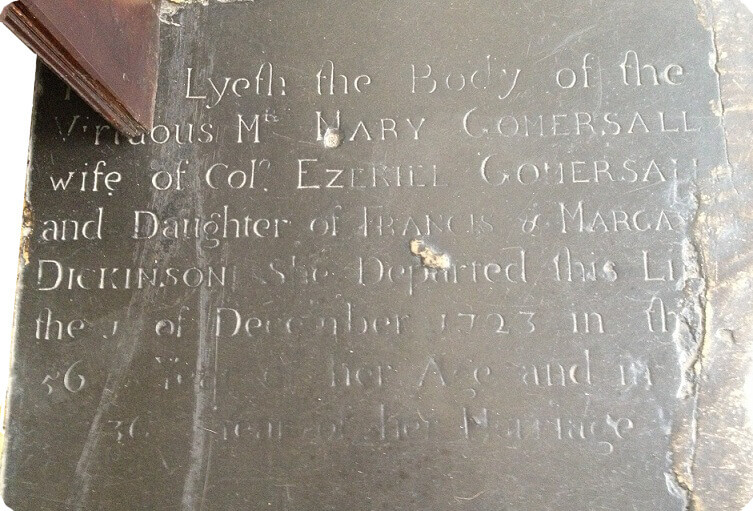
The Dickinsons in Jamaica's History
The Dickinson Family in Jamaica's History
The Dickinson family today, is most known for being the original owners of Appleton Estate, home of Appleton Rum. They owned many plantations, farms and pens in St Elizabeth, all originating from the initial land grant by the King of England to Frances Dickinson for his service in securing Jamaica for the crown. The family's influence also extended beyond the shores of Jamaica to North America, where Jonathan Dickinson, Frances's first son, became one of the early Mayors of Philadelphia, Pennsylvania.
The Dickinson family papers are kept at the Somerset Record Office and include records of the management of the family's Jamaican estates. The Dickinsons owned the estates of Barton Isles, Appleton, Pepper, Watchwell, Delacross Penn and Cherry Garden Estate.

Frances Dickinson (1632–1704)
Son of William Dickinson and Mary Colepepper and husband of Margaret Crook
William Dickinson - Rector of St Laurence Church, village of Appleton, England

St Laurence Church, Appleton, England
Frances Dickinson, also referred to as Francis, was the first Dickinson in Jamaica. He was granted 6,000 acres by King Charles II for his service in securing Jamaica from the Spanish. His father, William Dickinson, was the rector of St Laurence Church, in Appleton, England (close to Oxford) and his brother who lived in England, was the personal physician of the King Charles II.
Frances and his children started several estates and pens in St Elizabeth, including the estate that produces Appleton Rum that was named after Frances's home village, Appleton (located close to Oxford in England), where his father was rector of the village church.
- Frances Dickinson - had 3 sons and a daughter:
- Jonathan Dickinson (born in Jamaica)
- Caleb Dickinson (born in Jamaica)
- Jabez Dickinson (born in Pennsylvania, USA)
- Mary Dickinson (born in Jamaica)
Jonathan Dickinson (1663 - 1722)
Jonathan was born in Jamaica in 1663. He married Mary Gale in 1685 and they had four sons, Jonathan, Joseph, John, Isaac and two daughters, Mary (married Francis J. Tyssen of Jamaica) and Hannah.
He left Jamaica, four years after the devastation of Port Royal, his home port. He left for Philadelphia with his family and 10 slaves on a ship called Reformation in 1696. The ship got separated from the main fleet and was shipwrecked along the coast of Florida where they were captured by a hostile indian tribe called the Jobe. Fearing for their lives and facing hostility for days, they were eventually let go and travelled 230 miles to St Augustine... an ordeal that took 49 days. Jonathan eventually made it to Philadelphia where he later wrote an account of his harrowing experience in a book called "God's Protecting Providence". The book has been reprinted 25 times in English, German, and Dutch. Today, there is a State Park in Florida named after him, commemorating his experience.
Jonathan subsequently established a very successful merchant business in Philadelphia. He became one of the richest men in Philadelphia, owning several real estate holdings and a number of political positions in Pensylvania, including the Speaker of the Pennsylvania Assembly, several terms as an alderman for the city of Philadelphia, justice of the Supreme Court from 1711-1712 and twice Mayor of Philadelphia from 1712-1713 and 1717-1719.
Jonathan made several trips between Philadelphia and Jamaica, sometimes remaining for years at a time attending to business interests. Several letter books of his, held at the Historical Society of Pennsylvania and the Library Company of Philadelphia, provide a glimpse into his life. By maintaining nearly 10,000 acres in Jamaica, and a vast amount of real estate in Pennsylvania as well as trading on four continents, Jonathan Dickinson created a historical treasure trove of useful information for historians.
Caleb Dickinson (1670-1728)
The estates of Frances Dickinson was inherited by his second son Caleb, who married Sarah Vickris. The couple had three sons, Ezekiel, Caleb and Vickris, and two daughters, Margaret and Mary. Caleb Dickinson died on March 3rd, 1728 and is buried in Bristol. In his will, he extended the use of his house at Monks, Corsham, to his brother in law Ezekiel Gomershall, husband of his sister Mary and owner of the Cherry Garden Estate, should he decide to dwell in England.
Mary Dickinson (1667-1723)
 Here Lyeth the Body of the Virtuous Mrs. MARY GOMERSALL wife of Col. EZEKIEL GOMERSALL and Daughter of FRANCES & MARGARET DICKINSON. She Departed this Life the 1st of December 1723 in the 56th Year of her Age and in the 36th Year of her Marriage.
Here Lyeth the Body of the Virtuous Mrs. MARY GOMERSALL wife of Col. EZEKIEL GOMERSALL and Daughter of FRANCES & MARGARET DICKINSON. She Departed this Life the 1st of December 1723 in the 56th Year of her Age and in the 36th Year of her Marriage.Mary Dickinson was married to Ezekiel Gomersall, the owner of the Cherry Garden Great House, for about 36 years. On his death, the Cherry Garden Estate was left to Gomersall's 2nd wife and Ezekiel Dickinson, Mary's nephew, son of her brother Caleb Dickinson. The tie between Gomersall and the Dickinsons was enduring, with a trail of correspondence between him and Jonathan on a range of topics. The ties were strong enough for Ezekiel Gomersall to leave his estate to the son of Caleb Dickinson, and Caleb making provisions for him in his will.
- Frances Dickinson
- Jonathan Dickinson
- Caleb Dickinson
- Ezekiel Dickinson (1711 - 1788)
- Caleb Dickinson (1716 - 1783)
- Vickris Dickinson (1718 - 1797)
- Margaret Dickinson (1712 - 1780)
- Mary Dickinson (1713 - 1729)
- Jabez Dickinson
- Mary Dickinson
The Sons of Caleb Dickinson - Ezekiel, Caleb and Vickris
Ezekiel, Caleb and Vickris, inherited their father's Jamaican properties consisting of farms, sugar plantations and refineries in the parish of Elizabeth. They later acquired interests in additional estates in Jamaica derived from their uncle, Jonathan Dickinson. The brothers later divided the properties between them with Vickris running his share alone and Ezekiel and Caleb continuing joint ownership of properties in common.
Ezekiel and Caleb Dickinson owned 7,055 acres of land in St Elizabeth per the listings of the Jamaican Quit Rent books for 1754.
This arrangement between the brothers was continued by their offsprings. On Caleb’s side through his son William, grandson William and great-grandson Francis and on Ezekiel’s side through his son Barnard, Barnard‘s nephews Ezekiel Harman and Jeremiah Harman and their offsprings, until the estates were divided in about 1848.
In his Will, Vickris Dickinson left his estates in Jamaica to be divided 1/2 to Caleb, 1/4 to his son Charles, 1/12th to his daughter Mary Creswicke, and the remaining portion to Mary's children.
Ezekiel, the eldest brother, made his home at Bowden Park in Wiltshire and Caleb built himself a mansion at Kingweston, Somerton (near Glastonbury). Caleb expanded his properties in England eventually owning properties in East Lydford, Lympsham, Baltonsborough, Butleigh and Glastonbury. He also acquired the island of Flat Holm in the Bristol Channel and along with the lighthouse on the island.
Caleb Dickinson died on April 6, 1783 and was buried in the parish church of Kingweston leaving his estate to his only son, William, born on 13 July 1745. William Dickinson continued to oversee his inherited plantations in Jamaica, but shied away from the mercantile concerns of his father, with his interest turning to politics. He was a student at Edinburgh and then at the age of 23 became Member of Parliament for Great Marlow (Buckinghamshire) which he represented until he was defeated in 1774. He married Philippa Fuller in January 1771, daughter of Stephen Fuller of Brightling, Sussex, owner of considerable estates in Sussex where they had been prosperous ironmasters. She bore him a son also named William later that year.